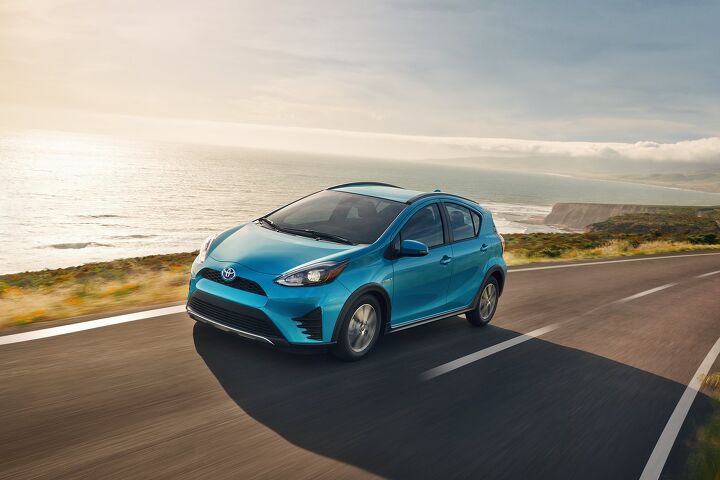Oh No They Didn't: Overnight, Toyota Turns 2018 Prius C Into a Land Cruiser Pretender
It started last year. Toyota, in concert with upgrading the Prius C with Toyota Safety Sense C added a matte black bodykit to the lower portions of the 2017 Prius C.
But for 2018, the Toyota Prius C is a veritable off-roader — a Rubicon-rolling, 4×4 river-fording FJ Cruiser successor.
The 2018 Prius C’s black cladding reaches up and around the wheel arches, and that cladding is interrupted at the Prius C’s chin by skidplate-aping metallic accents, heaven forfend.
Although the Toyota Prius C has migrated from the passenger car world to the trail-running SUV arena with nary a ride height increase and the same front-wheel-drive architecture, Toyota has managed to avoid fuel economy degradation. The 2018 Prius C is rated at 48 miles per gallon city, 43 highway, and 46 mpg combined, same as before.
More seriously, is crossoveresque styling enough to spur a measure of demand for the oft-rejected Prius C? Relatively uncommon upon its debut, U.S. Prius C sales peaked at 41,979 units in 2013, its first full year. But by 2016, sales were less than half that strong, plunging 47 percent from 2015 levels. Compared with last year’s poor performance, sales through the first half of 2017 tumbled a further 39 percent. Only 7,049 Prius Cs were sold in America during the first six months of 2017.
So far this year, the Prius C’s share of America’s subcompact market has fallen to 3.6 percent (from 4.8 percent a year ago) as Toyota generates the bulk of its subcompact sales with the Mazda 2-based Toyota Yaris iA. The Yaris iA and Yaris hatchback combine to outsell the Prius C by nearly four-to-one.
With no meaningful mechanical upgrades, the 2018 Toyota Prius C will still be the car that, according to Car And Driver, accelerates from 0-60 miles per hour in 10.9 seconds. Don’t expect to be thrilled, unless of course you leave the pavement and head up a mountain pass in the middle of a post-mudslide snowstorm.
The 2018 Toyota Prius C has a base price of $21,525, up almost $500 compared with the 2017 Toyota Prius C One.
[Images: Toyota]
Timothy Cain is a contributing analyst at The Truth About Cars and Autofocus.ca and the founder and former editor of GoodCarBadCar.net. Follow on Twitter @timcaincars.
More by Timothy Cain
Latest Car Reviews
Read moreLatest Product Reviews
Read moreRecent Comments
- 3-On-The-Tree My 2009 C6 corvette in black looks great when it’s all washed and waxed but after driving down my 1.3 mile long dirt road it’s a dust magnet. I like white because dust doesn’t how up easily. Both my current 2021 Tundra and previous 2014 Ford F-150 3.5L Ecobomb are white
- Bd2 Would be sweet on a Telluride.
- Luke42 When will they release a Gladiator 4xe?I don’t care what color it is, but I do care about being able to plug it in.
- Bd2 As I have posited here numerous times; the Hyundai Pony Coupe of 1974 was the most influential sports and, later on, supercar template. This Toyota is a prime example of Hyundai's primal influence upon the design industry. Just look at the years, 1976 > 1974, so the numbers bear Hyundai out and this Toyota is the copy.
- MaintenanceCosts Two of my four cars currently have tires that have remaining tread life but 2017 date codes. Time for a tire-stravaganza pretty soon.



































Comments
Join the conversation
The reason for promoting black plastic cladding is that it looks like crap after a few years and so lowers the value of used cars.
Now folks will buy them and say they bought a hybrid CUV, blissfully unaware that they have a...wait for it...wait for it...hatchback! Watch for sales to climb! (said slightly tongue in cheek)